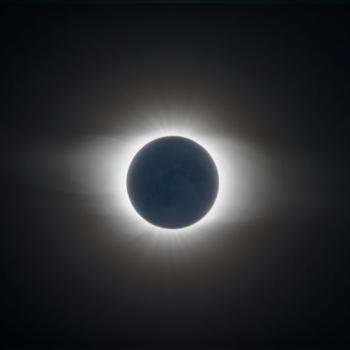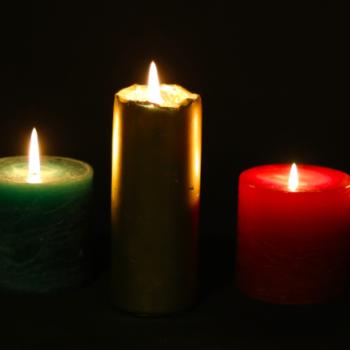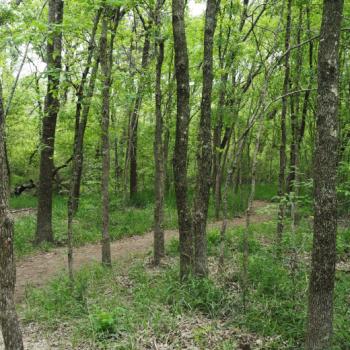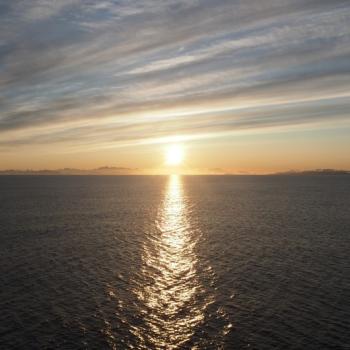Sermon – The Sacred Earth
The Denton Unitarian Universalist Fellowship
August 21, 2011
Introduction
One evening in a Buddhist monastery, a group of monks were cleaning up after dinner. One of the monks was less than fully present – he seemed to just want to get finished, whether the dishes were clean or not. Another monk noticed and said “remember – these are the Buddha’s bowls!” But an elder monk heard this and said “no, they are not the Buddha’s bowls. They are the Buddha’s flesh.”
What is our relationship with the natural world? Is the Earth a thing here for us to exploit as we see fit? Is it the property of a divine overlord who left it in our care? Or is it the flesh of the Buddha and the body of the Goddess, due reverence and respect because it is sacred in and of itself?
Religions Come and Go
In a closed society religion is mostly fixed. People believe and act in the ways of their parents and their grandparents before them. Practices believed to be sacred will be continued long after everyone has forgotten why they were thought important, and long after they cease to be helpful. Deviating from the way things have always been done is risky – it may displease the gods or the ancestors, who may remove their protection from the tribe. If the herds disappear, if the harvests are slim, if the stock market goes down, it’s a sign to purify yourself from the new and the foreign and return to the way things were done when times were good.
In an open society religion is very changeable. While some will cling to what is familiar regardless of the situation, most people take a very utilitarian approach to religion. If it helps them, they’ll keep doing it. If it doesn’t they’ll look for something else. Most of us know this first-hand – most of us grew up in a religion other than Unitarian Universalism. Maybe we could no longer believe what we were told we had to believe. Maybe we were told we didn’t belong because of who we loved. Or maybe we were told there is nothing besides the material world and “religion poisons everything.” Regardless of why, we left the religion of our upbringing and made our way here because we felt a need for something different… and because we were free to choose.
A new religious movement is rising here and now. It shares many roots with Unitarian Universalism, and other roots go back to the earliest humans walking the plains of Africa. This new religious movement is “one where nature is sacred, has intrinsic value, and is therefore due reverent care.” Some call this Green Religion, Environmental Religion, or Nature Religion. Bron Taylor, Professor of Religion and Nature at the University of Florida has written a book describing it and naming it “Dark Green Religion.”
The Origins of Green Religion
Dark Green Religion has its origins in the beliefs and practices of indigenous people – hunters and gatherers whose lives are inseparably intertwined with Nature. But its more recent origins are in the excesses and shortcomings of the modern Western world. The industrial revolution made material goods cheap and widely available, it raised our standard of living immensely. But it also brought pollution, deforestation, and shift work. It transferred the majority of people from living on the land to living in cities, isolated from the land.
Removed from Nature, people began to long for Nature. And when they experienced it first hand – especially in the wild new world of North America – they were struck with those most ancient religious impulses, wonder and awe. It is no surprise that the spiritual ancestors of Nature religion are mostly Americans – people like Ralph Waldo Emerson, Henry David Thoreau and John Muir.
Writing near the end of his life in 1912, Muir said “Everybody needs beauty as well as bread, places to play in and pray in, where nature may heal and give strength to body and soul alike.”
In “The Method of Nature,” Emerson wrote: “Shall we not quit our companions, and betake… some unvisited recess in Moosehead Lake, to bewail our innocency and recover it, and with it the power to communicate again with these sharers of a more sacred idea.”
In the words of Bron Taylor, Nature is sacred, has intrinsic value, and is therefore due reverent care.
Sacred Stories
Contrary to what some would tell you, choosing a religion isn’t about affirming or denying a set of supernatural propositions. Nor is it about accepting a certain moral code. Choosing a religion is about identifying with a sacred story. There is still power in the sacred stories of the orthodox religions, but that power has frequently been expressed in ways that are proving unhelpful to the future of humanity.
There are several sacred stories in Dark Green Religion.
14 billion years ago, All was truly One. Everything in our Universe was compressed into a single point of seemingly infinite density. The atoms that make up your body and the particles that make up those atoms were mixed with the particles and atoms that make up my body and the bodies of every animal, vegetable and mineral on this planet and throughout the universe.
And then, in an instant, it exploded, sending matter and energy out in all directions. Eventually, some of that matter and energy began to coalesce into galaxies and stars and planets. One of those planets was just the right distance from its parent star – it had water in liquid form. From that water, through some event or process we still don’t understand, life began. First in single-cell organisms, then in a series of ever more complex forms, biological life evolved into the beautiful diversity we know today. Everything alive on this planet can trace its ancestry back to that first single-celled organism.
The Big Bang and evolution are more than scientific theories. They are sacred stories. They tell us who we are, where we came from, and who our family is. We may be the most intelligent creatures in this world, but the difference between humans and other animals is one of degree, not one of kind. They are – quite literally – our relatives, and we are all dependent on the Earth to sustain our lives. If we have inherent value and rights then so do they.
The story of life on Earth is so unlikely it can properly be called miraculous, but there is nothing supernatural about it. As this sacred story shows, Dark Green Religion can be practiced non-theistically.
St. Francis couldn’t have known about the Big Bang and evolution, but he still called the wolf his brother. The recognition of this kind of kinship was remarkable for medieval Europe, but it was hardly original. Our earliest ancestors saw it – they guessed that whatever spirit or spirits animate us also animate the wolf, the bear, and the boar. Some spirit must animate the winds and the tides, the trees and the herbs, even the mountains and the plains.
We have moved beyond uninformed superstition. We know the Sun is not driven across the sky in a chariot each day and we know it does not pass through the Underworld in a boat each night. But for all our brilliant knowledge and magical technology, we still don’t know how life began. We still don’t know what happens to our beautiful consciousness when we die. Is it really such a stretch to believe that everything has a spirit?
And if everything has a spirit, then everything is sacred, has intrinsic value, and is therefore due reverent care.
British scientist James Lovelock first articulated the Gaia Hypothesis, which proposes that the Earth is a living organism of which we are but a part, just as our hearts and livers and skin are living but a part of us. Lovelock says we must acknowledge our integration with and dependence on Gaia. If we do not, “we will, by thinking selfishly only of the welfare of humans and ignoring Gaia, have caused our own near extinction.” But we have another choice. Lovelock says “if you put trust in Gaia, it can be a commitment as strong and as joyful as that of a good marriage, one where the partners put their trust in one another and since they are, as Gaia is, mortal, their trust is made even more precious.”
Our Place in the Grand Scheme of Things
One thing Dark Green Religion is NOT about is “saving the planet.” The Earth was here a couple billion years before we got here and the odds are good it will be here long after we’re gone. The Earth is bigger, stronger, and more resilient than humans – we couldn’t destroy the Earth if we wanted to. The Earth doesn’t need humans to save it any more than we need our skin or our spleen to save us.
But if you studied elementary school science or if you watch National Geographic, you know what happens when a species loses its natural predators. It begins to reproduce faster and faster, it consumes more and more resources, till finally it exceeds the carrying capacity of its ecosystem. Famine, starvation, and death follow.
The spiritual outcome of providing reverent care to Nature is a confirmation that Nature is indeed sacred. The material outcome is not saving the Earth, it’s saving ourselves, our fellow humans and fellow creatures.
Practicing Dark Green Religion
We’ve looked at the concept of Dark Green Religion and we’ve heard its sacred stories. Now, what does it look like in practice?
If Dark Green Religion is a response to being disconnected from Nature, then one of the first goals is to re-establish our connections with the natural world. This isn’t complicated – it simply requires us to go outside for a few minutes every day. Follow the Sun and see for yourself how it rises and sets at different points on the horizon during the year. Follow the Moon and see for yourself how it rises and sets a little later every day, and how its shape changes during the month. Look up at the stars and contemplate how long ago the light reaching your eyes has been traveling through space.
We’re so used to living in antiseptic, climate controlled enclosures with electronic entertainment blaring at us all day long, we’ve forgotten how to use our senses. Sit outside and listen. What do you hear? Take a breath – what do you smell? Open your eyes – what do you see? Walk barefoot through the grass, touch a flower, hug a tree. Get down on your hands and knees and see how many living things you can find in your yard. Make a real connection to Nature using your whole being, not just your mind.
Go for a walk. Exercise isn’t just good for your body, it’s good for your soul. Feel your breath going in and out, feel your muscles stretching and contracting, feel your heart beating faster and the sweat rising to cool your body. Look around and see other animals doing the same thing.
When we establish our connections to the natural world, it begins to affect us. We start to feel the intrinsic value of Nature, and we start thinking about what reverent care might look like.
A few people are called to a life of subsistence farming and extreme simplicity. I admire them – they show us what can be done, and how little we truly need. But technology isn’t a bad thing in and of itself. I’m thankful we have clean water, modern medicine, and the internet. And I have NO desire to live in Texas without air conditioning! But while it is neither necessary nor desirable for all of us to return to a preindustrial technology, our call to reverent care requires us to examine how we live and what impact we make on our world.
We UUs are pretty good about asking where things come from. We need to also ask where they will go when we are finished with them. Recycling is good. Reusing is better. Using less in the first place is better still. It’s better for Nature and it’s better for our finances. There’s a reason why so many businesses are “going green” – and it’s not just for the publicity. There are real financial savings in using less energy.
Change to high efficiency light bulbs. Install high efficiency heating and cooling equipment. Make your next vehicle smaller and more fuel efficient. Walk, bicycle, or take public transportation where you can. Turn off lights and unplug appliances you aren’t using. Some of these require an up front investment but many simply require changing your habits.
These are not commandments that must be obeyed. They’re ideas for putting your faith into action.
Social and Political Action
If we truly believe Nature is sacred, has intrinsic value, and is therefore due reverent care, we will change the way we live. We will also work to change society.
In April of this year, Bolivia passed a law titled “The Rights of Mother Earth.” This law declares that Nature has inherent rights, including “the right to life and to exist; the right to continue vital cycles and processes free from human alteration; the right to pure water and clean air; the right not to be polluted; and the right to not have cellular structure modified or genetically altered.”
If such a law seems unimaginable in the United States, you are literally correct. It cannot be imagined because it does not fit into the majority worldviews in this country.
The majority religious worldview teaches that the Earth was created by a supreme being who then gave humans “dominion” over it. This worldview is based on a hierarchy of ownership: all rights belong to the owner, who can do with the owned as he pleases. One of the few things I remember from a business law class was the principle that “the value of a thing is what it will bring in an open market” – no thing, not even the Earth itself, has value of its own, only what value is derived from its usefulness or desirability to humans.
The majority secular worldview in this country claims the autonomy of the individual human is the greatest good. Bolivia’s new law demands that the rights of humans be balanced against the rights of the Earth. Some will see this as an infringement on their autonomy, and they will frame their arguments as a human battle – those who want to protect the Earth vs. those who want to exploit the Earth. Or worse, they will paint protecting the Earth as “oppression” and exploiting it as “freedom.” They will never consider that the Earth has rights which should also be valued and respected.
What we believe about the universe determines what we can imagine, and what we can imagine determines what we can create. I am thankful that the people of Bolivia have created something the people of the United States could not. Through our work and through our lives, some day that will change.
A New Civil Religion
Though we like to put religion in a box, the truth is that religion is impossible to separate from culture. Religion isn’t just about what you believe – it’s about what you do. The things we hold sacred in common and the things we do in common form our civil religion – the non-theistic or deistic beliefs and practices which help bind our diverse country together. Our American civil religion has its pantheon – Washington, Jefferson, Lincoln. It has its holy days – the fourth of July, Labor Day. It has its sacred rituals – Thanksgiving, the Super Bowl.
To these we are adding elements of Environmental Religion. Earth Day is a new holy day. Green practices such as recycling and energy conservation are becoming sacred obligations.
Green themes are turning up in our art and entertainment: the movie Avatar is only the most obvious example.
There are pilgrimages – ecotourism is a booming business, taking people to see Nature in its wildest and most diverse states. There is concern that the traffic to these places is harming the very things we wish to honor and preserve, but there is no question that the desire to visit these beautiful places is a religious impulse.
Nature is sacred, has intrinsic value, and is therefore due reverent care in our civil society as well as in our personal lives.
The Backlash
You know you’re accomplishing something when folks on the other side of the religious spectrum start screaming that you’re dangerous.
A group of Christian fundamentalists is campaigning against environmentalism, calling it “the green dragon.” The name is an obvious attempt to associate the whole green movement with the dragon of Revelation – Satan – and with the “end times” many fundamentalists eagerly anticipate. Their target isn’t just Pagans and secular environmentalists – it’s also an attempt to isolate liberal Evangelicals who believe we should care for what they see as God’s creation. Their accusations range from the willfully ignorant to outright lies – which they’ll be happy to explain in their 6-hour DVD set for only $49.95.
Richard Land of the Southern Baptist Convention wins the award for unintended irony. He says “Environmentalists have a long history of believing and promoting exaggerations and myths.”
Is Dark Green Religion dangerous? Any religion that’s worthwhile is dangerous – dangerous to the unexamined life, dangerous to habits that have become comfortable but which do not help ourselves or others. It’s dangerous to those who have great wealth and power invested in a system that no longer serves the needs of the people and the needs of the planet.
Whatever future religion ends up looking like, it will proclaim that Nature is sacred, has intrinsic value, and is therefore due reverent care.
Incorporating With Other Religions
The Spirit of the Earth is not a jealous goddess. She doesn’t care if you follow Jesus or Buddha, if you celebrate Christmas or Ramadan, so long as you also honor and care for her. Dark Green Religion can be easily incorporated into other religions – something that should appeal to us UUs with our tendency to “borrow and blend.”
Nature Religion works well with Christianity, and a growing number of Christians are environmentalists. Green Christianity is a stewardship model – it says we should care for the Earth because it is God’s creation, not because it has value of its own. Doing the right things for different reasons is still doing the right things.
Dark Green Religion works well with Paganism, but it is not Pagan. There are few connections to our ancestors and there is no emphasis on relationships with the gods and goddesses who may or may not be personified forces of Nature. Some elements of modern Paganism fit well with Environmental Religion, most notably the concept of the Eightfold Year. These celebrations have their roots in ancient agricultural cycles, but in our time they help keep us attuned to the rhythms and cycles of the Earth.
At Imbolc in February we see the first signs of Spring, even though Winter is far from over. At the Spring Equinox we celebrate planting, and at Beltane we celebrate fertility in all its many forms. At the Summer Solstice we mark the longest day and at Lughnasadh we celebrate the first harvest. At the Autumn Equinox we celebrate the apple harvest. At Samhain, we pay tribute to our ancestors and acknowledge that some day we leave this world and join them. At the Winter Solstice the Sun is reborn, and the cycle begins again.
All these holidays have some correspondence in the modern world – Groundhog Day with Imbolc, Halloween with Samhain, and the many religious and cultural holidays around the Winter Solstice. It is very easy to include an observance of the turning of the seasons and the Earth, and in doing so reinforcing the idea that Nature is sacred, has intrinsic value, and is therefore due reverent care.
Conclusion
Many of the world’s remaining tribal societies have no word for “religion” – or if they do, it refers to what’s preached to them by Christian or Islamic missionaries. Their own beliefs and practices are simply part of who they are and what they do.
Who are we, and what do we do?
We’re people who recognize we weren’t placed on the Earth, we grew out of the Earth. We stand in awe of the power and beauty of Nature, even as we struggle to know if that power and beauty comes from God or Goddess or if it simply is. We understand something so beautiful and powerful is sacred and has inherent value of its own. And we know our sacred obligation is to care for the Earth reverently, diligently, intelligently, and lovingly.
Some call this Green Religion, Environmental Religion, or Nature Religion. Bron Taylor calls it Dark Green Religion. I call it the Sacred Earth.

















